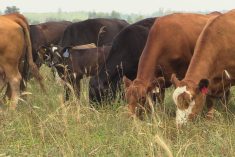Alberta packers were buying fed cattle on a dressed basis in the range of $262-$265 delivered this past week. Using a 60 per cent grading, the live price would be in the range of $157-$159.
If a feedlot booked the bulk of its feed grains earlier in winter, feeding margins are now hovering in positive territory. Strength in the fed cattle market appeared to spill over into the feeder complex. Compared to last week, western Canadian feeder cattle markets traded $3 lower to $3 higher on average. A firmer tone was noted in Alberta and certain regions of Saskatchewan while the Manitoba markets felt somewhat sluggish. Quality yearlings and low-flesh backgrounded cattle were met with strong buying interest. Calves were rather soft and barely held value with the stronger feed grain prices. After a dismal year of cattle feeding, feedlot operators have a sharp pencil.
Read Also

JBS profit falls amid still-challenging US market environment
JBS, the world’s largest meat company, reported a net profit fall in the third quarter in spite of a rise in global net sales amid a still-challenging beef market environment in the U.S., according to an earnings statement on Thursday.
In central Alberta, mixed steers on a full health program coming fed a light grain ration and averaging 760 lbs. were valued at $203; larger-frame tan heifers of similar characteristics weighing just over 710 lbs. reached up to $195. In southern Alberta, mixed Simmental-blended steers on very light grain and forage ration with full health program benefits weighing 855 lbs. were quoted at $189. In Manitoba, a small group of black steers with medium flesh weighing 830 lbs. were valued at $174; Charolais-based heifers averaging 845 lbs. were quoted at $161 northwest of Winnipeg.
Yearlings in the eastern Prairie regions were softer than in Alberta; however, the opposite price structure was evident on calves. In western Manitoba, larger-frame Charolais-based steers weighing 630 lbs. were valued at $230 and similar-quality 550-weight steers reached up to $250. In central Alberta, mixed steers weighing just over 650 lbs. were valued at $204 and 565-lb. steers were quoted at $232.
Much of Western Canada has received less than 40 per cent of normal precipitation and the grasser market is feeling the effects of lower demand. These lighter calves are moving straight in the backgrounding lot. Drought-like conditions are a significant risk moving forward because there is no major rain event in the seven- to 10-day forecast. If Western Canada doesn’t receive rain soon, the market is going to be overwhelmed with calves. Forage supplies from last year are also rather snug. Pastures are in poor shape across the Canadian Prairies. The U.S. northern Plains are in severe drought.
— Jerry Klassen manages the Canadian office of Swiss-based grain trader GAP SA Grains and Produits Ltd. and is president and founder of Resilient Capital, specializing in proprietary commodity futures trading and market analysis. Jerry consults with feedlots on risk management and writes a weekly cattle market commentary. He can be reached at 204-504-8339 or via his website at ResilCapital.com.















